
SaGa (サガ) is a series of science fantasy role-playing video games by Square Enix. The series originated on the Game Boy in 1989 as the creation of Akitoshi Kawazu at Square. It has since continued across multiple platforms, from the Super NES to the PlayStation 2 to mobile phones, PCs, and modern multi-platform console releases. The series is notable for its emphasis on open world exploration, non-linear branching plots, and occasionally unconventional gameplay. This distinguishes the games from most of Square's other franchises.

PaRappa the Rapper 2 is a 2001 rhythm video game developed by NanaOn-Sha and published by Sony Computer Entertainment for the PlayStation 2. It is the third and most recent title in the PaRappa the Rapper series, following Um Jammer Lammy. The game was made available for the PlayStation 4 through the PlayStation Network in December 2015.

Vib-Ribbon is a 1999 rhythm video game developed by NanaOn-Sha and published by Sony Computer Entertainment for the PlayStation. The game came out in Japan on December 9, 1999 and in Europe on September 1, 2000, but was never released for the PlayStation in North America; it was re-released on the PlayStation 3 via PlayStation Network in October 2014, which finally brought the game to North America in addition to Japan and Europe. NanaOn-Sha had previously developed the PaRappa the Rapper series of games for Sony.

PaRappa Rappa is a fictional character created by Japanese musician Masaya Matsuura and American artist Rodney Greenblat. PaRappa first appears as the title character of the 1996 rhythm video game PaRappa the Rapper, developed by NanaOn-Sha for Sony Interactive Entertainment's PlayStation console.

Japanese calligraphy, also called shūji (習字), is a form of calligraphy, or artistic writing, of the Japanese language. Written Japanese was originally based on Chinese characters only, but the advent of the hiragana and katakana Japanese syllabaries resulted in intrinsically Japanese calligraphy styles.
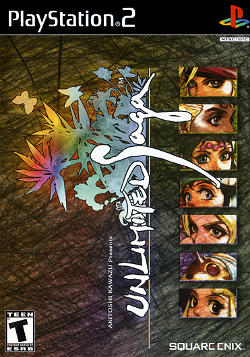
Unlimited Saga is a 2002 role-playing video game developed and published by Square for the PlayStation 2 as the ninth game in the SaGa series. It was released in 2002 in Japan and 2003 in North America and Europe; its European version was published by Atari Europe. The story follows seven characters as they explore mysteries connected to the Seven Wonders, artifacts left by an ancient civilization said to be capable of triggering a golden age. Battles carry over the skill-based levelling systems and nonlinear structure of earlier SaGa titles, with an exploration structure similar to a board game.
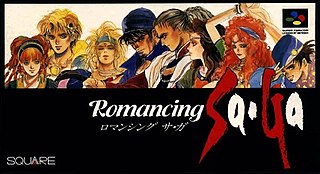
Romancing SaGa is a 1992 role-playing video game developed and published by Square for the Super Famicom. It is the fourth entry in the SaGa series. It was subsequently released for the WonderSwan Color in 2001 and mobile phones in 2009. A remake for the PlayStation 2, subtitled Minstrel Song in Japan, was released in both Japan and North America in 2005 by Square Enix. A remaster of Minstrel Song was released worldwide in 2022 for Android, iOS, Nintendo Switch, PlayStation 4, PlayStation 5 and Windows.
NanaOn-Sha is a Japanese video game developer founded by Masaya Matsuura in 1993.

Tenchu: Stealth Assassins is a 1998 stealth video game developed by Acquire for the PlayStation. The debut entry in the Tenchu series, it was published in Japan by Sony Music Entertainment Japan, and by Activision in the West. Following Rikimaru and Ayame of the Azuma ninja clan as they complete missions for their employer Lord Gohda in Sengoku-era Japan, the gameplay involves the player guiding their chosen character through missions, the aim being to remain undetected while either avoiding or quietly killing enemies.

Psy・S [sáiz] (サイズ) was a Japanese progressive pop/rock band, formed in 1983 by Masaya Matsuura alongside female vocal powerhouse Chaka. After Japanese hits and successes throughout the late 1980s and early 1990s, they disbanded in 1996.

Masaya Matsuura is a Japanese musician and video game designer based in Tokyo, Japan. He was born in Osaka on June 16, 1961, and majored in Industrial Society at Ritsumeikan University. He has worked extensively with music production, sound design, and visuals, and has been active with the J-pop duo Psy-S. He has also been credited with popularizing the modern music video game at his studio NanaOn-Sha.

Vib-Ripple is a 2004 video game developed by NanaOn-Sha and published by Sony Computer Entertainment for the PlayStation 2. It was designed by Masaya Matsuura, who also led the development the 1999 PlayStation game Vib-Ribbon, to which Vib-Ripple is a sequel. It was released exclusively in Japan.
PaRappa the Rapper is a 2001 American-Japanese anime television series based on and a prequel to NanaOn-Sha's PaRappa the Rapper video game series created by Masaya Matsuura and Rodney Alan Greenblat. The series was produced by J.C.Staff and aired in Japan on Fuji TV between April 2001 and January 2002, running for thirty episodes. Episodes 29 and 30 aired together as a 1-hour special.

Um Jammer Lammy is a 1999 rhythm video game developed by NanaOn-Sha and published by Sony Computer Entertainment for the PlayStation. It is a spin-off and follow up to 1996's PaRappa the Rapper, once again featuring the collaboration of music producer and game designer Masaya Matsuura and artist Rodney Alan Greenblat. An arcade version co-developed by Namco, titled Um Jammer Lammy NOW!, was released in Japanese arcades in December 1999. The game received generally positive reviews from critics.
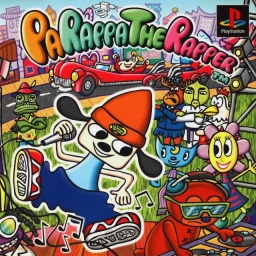
PaRappa the Rapper is a rhythm video game developed by NanaOn-Sha and published by Sony Computer Entertainment for the PlayStation. It was originally released in Japan in 1996 and worldwide in 1997. Created by music producer Masaya Matsuura in collaboration with artist Rodney Greenblat, the game features unique visual design and rap-based gameplay and is considered to be the first true rhythm game. It was ported to the PlayStation Portable in 2006 in celebration of its 10-year anniversary. A remastered version of the original PlayStation game was released for PlayStation 4 in 2017 for the game's twentieth anniversary.

PlayStation Underground was an American video game magazine, originally published by Sony Computer Entertainment America. The magazine focused on the PlayStation fanbase, including gaming on the original Sony PlayStation and the PlayStation 2, and was promoted as a "PlayStation fan club". Unlike its paper-based counterpart the Official U.S. PlayStation Magazine, PlayStation Underground came in the form of CD-ROMs which could be played on the PlayStation and PlayStation 2 consoles. Subscribers were also given access to a members-only website. The magazine released its first issue on March 26, 1997 and its final issue in 2001. The magazine released a total of seventeen issues during its active years. The magazine was eventually merged with Official U.S. PlayStation Magazine in 2001 when it was discontinued.
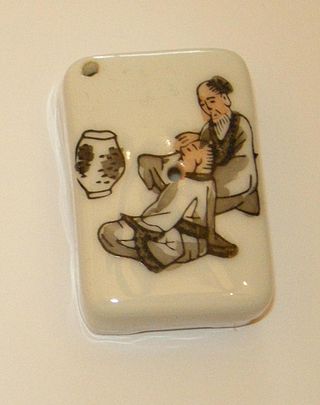
A water-dropper is a small device used in East Asian calligraphy as a container designed to hold a small amount of water. In order to make ink a few drops of water are dropped onto the surface of an inkstone. By grinding an inkstick into this water on the inkstone, particles come off and mix with the water, forming ink.

Arslan: The Warriors of Legend is a hack and slash video game developed by Omega Force and published by Koei Tecmo. It is a crossover between Hiromu Arakawa's manga adaptation of The Heroic Legend of Arslan and Koei Tecmo's Dynasty Warriors series.

Project Rap Rabbit is a cancelled rhythm game formerly in development by NanaOn-Sha and iNiS for PlayStation 4 and Microsoft Windows. The game, directed by Masaya Matsuura in collaboration with Keiichi Yano, is pitched as a revival of story-based rhythm games such as PaRappa the Rapper and Gitaroo Man, and features rap battle gameplay mixed with Japanese culture. Following the game's failure to secure financing on crowdfunding website Kickstarter, the game's development has been placed on hold.
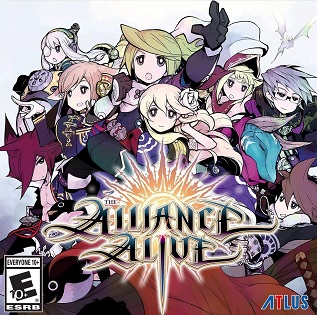
The Alliance Alive is a role-playing video game developed by Cattle Call for the Nintendo 3DS. The game was released in Japan by FuRyu in 2017, and was released worldwide by Atlus USA in 2018. The story follows a group of characters as they mount a rebellion against a race of Daemons that have ruled over humans since blotting out the sun a millennium before. Gameplay follows many traditions of the Japanese role-playing genre, including turn-based battles and navigation using a world map.

















